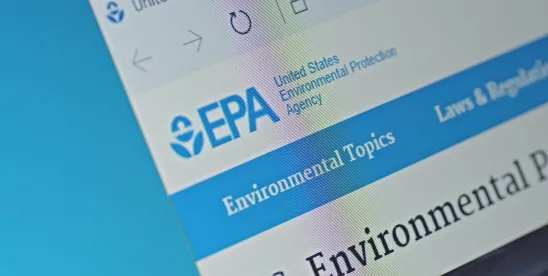After nearly two decades of litigation, the U.S. Environmental Protection Agency (EPA) recently finalized a suite of four regulations targeting the power sector. The rules aim to address greenhouse gas (GHG) emissions, mercury pollution, wastewater management, and coal ash disposal.
Predecessors to the current GHG and mercury rules faced particularly close judicial scrutiny, with the former giving rise to the Supreme Court’s landmark 2022 decision in West Virginia v. EPA, 597 U.S. 697 (2022), which held that the “major questions doctrine” prevented EPA from regulating GHG emissions beyond facility fence lines absent a clear expression of Congressional intent. Likewise, the high court previously struck down the EPA’s Mercury and Air Toxics (MATs) rule in 2015 for the agency’s failure to consider costs in setting standards for the substances. See Michigan v. EPA, 576 U.S. 743.
This blog post supplies an overview of each regulation, highlighting their technical requirements and examining the potential legal ramifications in light of recent Supreme Court decisions.
1. Greenhouse Gas Emission Standards for Power Plants
The EPA’s updated greenhouse gas emissions rule is a mouthful: New Source Performance Standards for Greenhouse Gas Emissions from New, Modified, and Reconstructed Fossil Fuel-Fired Electric Generating Units; Emission Guidelines for Greenhouse Gas Emissions from Existing Fossil Fuel-Fired Electric Generating Units; and Repeal of the Affordable Clean Energy Rule (“GHG Rule”).[1] But the long title belies the GHG Rule’s simple goal: to limit GHG emissions from new and existing coal-fired power plants.
Invoking the authority of Clean Air Act section 111, 42 U.S.C. § 7411, the EPA introduces stringent CO2 emission standards for both new and existing coal-fired electric utility generating units (EGUs)—natural gas-fired plants will be considered in a future rule—emphasizing the Best System of Emission Reduction (BSER) while considering costs, environmental impacts, and energy needs.
For existing coal-fired power plants that plan to operate beyond 2032, the rule sets forth rigorous emissions guidelines, necessitating adherence to detailed operational timelines to avoid compliance violations. The EPA claims the new rule enhances compliance flexibility through mechanisms such as emission averaging and trading, allowing states to customize approaches to align with their unique regulatory environments. Innovations like partial carbon capture and storage (CCS) are integrated, establishing a carbon intensity goal of no more than 1,400 pounds of CO2 per MWh for existing units, aimed at reducing emissions by approximately 10% from 2005 levels by 2030.
The EPA predicts that these measures will result in a significant decrease in CO2 emissions from the power sector—exceeding more than 62% below 2022 levels by 2035, and more than 83% below 2005 levels by 2040. Additionally, the rules are projected to yield considerable public health benefits, including the prevention of up to 1,200 premature deaths and the reduction of tens of thousands of tons of NOx, SO2, and fine particulate matter (PM2.5) annually by 2035. This rule is seen as a key part of the Biden administration’s broader strategy to combat climate change and promote public health through enhanced environmental standards.
2. Mercury and Air Toxics Standards (MATS) Revisions
Likewise, the National Emission Standards for Hazardous Air Pollutants: Coal- and Oil-Fired Electric Utility Steam Generating Units Review of the Residual Risk and Technology Review regulation finalizes amendments to the (NESHAPs) for coal and oil power plants as part of the EPA’s follow-up to its 2020 Residual Risk and Technology Review (RTR).
Key changes include updating the filterable particulate matter (fPM) emission standards to serve as a surrogate for non-mercury metal HAPs for existing coal-fired EGUs, revising the fPM emission standard compliance requirements, and tightening the mercury emission standard for lignite-fired EGUs to 1.2 lb/TBtu on a rolling 12-month average. Additionally, the definition of “startup” has been revised to limit and define the term, focusing exclusively on the first firing of fuel in a boiler, applicable to both its first-ever operation and following any shutdown event. No changes were made to the RTR itself.
Responding to the Circuit Court’s directives in Michigan v. EPA, 576 U.S. 743, 135 S. Ct. 2699 (2015), the EPA incorporated cost considerations in the MATS rule and adopted the latest emission control technologies. The updates set strict new limits on mercury emissions, achieving a 70% reduction for lignite-fired plants and a two-thirds reduction of fPM, which helps control emissions of non-mercury metal Hazardous Air Pollutants (HAPs). The amendments also mandate the use of Continuous Emission Monitoring Systems (CEMS).
According to EPA projections, by 2028 the revised rule will reduce mercury emissions from power plants by 1,000 pounds, PM by 770 tons by 2028, NOx by 280 tons, and CO2 by 65,000 tons. The inclusion of CEMS for PM is expected to enhance the accuracy and reliability of emissions data, contributing to better compliance and operational improvements at power plants. EPA describes these proposed as being both technologically feasible and economically achievable and intended to result in significant public health improvements.
3. Enhanced Effluent Limitation Guidelines (ELGs) for Coal Plant Wastewater
The updated Supplemental Effluent Limitations Guidelines and Standards for the Steam Electric Power Generating Point Source Category revise the federal Clean Water Act’s Enhanced Effluent Limitation Guidelines (ELGs) Coal Plant Wastewater to address the environmental concerns associated with wastewater discharges from coal-fired power plants. These updates specifically target flue gas desulfurization (FGD) wastewater, bottom ash (BA) transport water, legacy wastewater at existing sources, and combustion residual leachate (CRL) at both new and existing sources. Last updated in 2015 and 2020, these revised standards include the implementation of zero liquid discharge (ZLD) technologies for FGD wastewater, aimed at eliminating the release of harmful pollutants such as arsenic, mercury, and selenium into surface waters.
The new guidelines impose stringent standards and prohibit all discharges of FGD wastewater, BA transport water, and coal residual leachate, alongside phased limitations for facilities planning to cease coal combustion.
The EPA predicts that these measures will reduce pollutant discharges by approximately 660 to 672 million pounds per year, with projected additional annual costs ranging from $536 million to $1.1 billion. Furthermore, the rule mandates the closure and remediation of legacy coal combustion residuals (CCR) surface impoundments, incorporating new requirements for groundwater monitoring, corrective action, and post-closure care. The rule also makes adjustments to previously less stringent Best Available Technology Economically Achievable (BAT) requirements for certain subcategories from 2020, reinforcing reporting and recordkeeping to ensure compliance after electric generating units cease coal combustion.
4. Comprehensive Regulation of Coal Combustion Residuals (CCR)
Finally, the fourth in EPA’s suite of rules, Hazardous and Solid Waste Management System: Disposal of Coal Combustion Residuals from Electric Utilities; Legacy CCR Surface Impoundments, extends regulatory oversight to include coal ash impoundments at inactive sites. It sets stringent environmental standards to prevent the contamination of waterways, groundwater, and ecosystems from harmful substances such as mercury, cadmium, and arsenic, imposing strict zero-discharge limits for pollutants in flue gas desulfurization (FGD) wastewater, bottom ash transport water, and combustion residual leachate (CRL). Additionally, the rule allows a specific number of facilities to demonstrate, based on groundwater data and impoundment design, that their operations will not adversely affect human health or the environment.
The regulations mandate comprehensive compliance protocols, including groundwater monitoring, corrective action, closure, and post-closure care for coal combustion residuals (CCR) management units. They require all coal-fired and new baseload gas-fired plants to control 90% of their carbon emissions and adjust compliance timelines to facilitate the planning processes of power companies in meeting electricity demands while reducing pollution. The rule also modifies less stringent Best Available Technology (BAT) requirements for certain subcategories, particularly relating to the cessation of coal combustion.
By expanding application to electric utilities or independent power producers that ceased electricity production prior to October 19, 2015, and possess a legacy CCR surface impoundment, the regulation ensures these facilities meet contemporary environmental standards. This rule is intended to bridge critical regulatory gaps, ensuring all coal ash storage facilities, active or inactive, adhere to consistent safety and management practices. The ultimate effectiveness of this rule will depend on proper implementation and continuous compliance monitoring.
GT INSIGHTS
EPA regulation of the power sector tends to generate significant public and industry interest—and lawsuits. While no one knows how these newest regulations will fare against a backdrop of judicial skepticism of broad claims of authority, the EPA believes its new rulemaking strikes the correct balance and conforms to the relevant judicial precedents.
But the heavy economic burden of these rules cannot be overstated. By the EPA’s own analyses, the collective cost of the combined rules will exceed a staggering ten billion dollars by 2030. With so much at stake, courts will inevitably be called upon to figure out whether the new regulations would require use of technologies that are either too costly or not yet adequately demonstrated, and ultimately, whether the new regulations strike the right balance between benefits and burdens and conform with the authorities Congress vested in the agency.
[1] In this blog post we link to the pre-publication versions of the rules, which as of this writing have not yet been published in the Federal Register.




 />i
/>i

